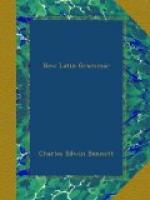... ignar^i hominumque locorum^que
erramus.
7. Tmesis (cutting). Compound words are occasionally separated into their elements; as,—
quo me cumque rapit tempestas, for quocumque, etc.
8. Syncope. A short vowel is sometimes dropped between two consonants; as,—
repostus for repositus
THE DACTYLIC HEXAMETER.
368. 1. The Dactylic Hexameter, or Heroic Verse, consists theoretically of six dactyls. But in all the feet except the fifth, a spondee ( _ _ ) may take the place of the dactyl. The sixth foot may be either a spondee or a trochee, since the final syllable of a verse may be either long or short (syllaba anceps). The following represents the scheme of the verse:—
_/ vv (or _) ; _/ vv (or _) ; _/ vv (or _) ; _/ vv (or _) ; _/ vv ; _/ v (or _).
2. Sometimes we find a spondee in the fifth foot. Such verses are called Spondaic. A dactyl usually stands in the fourth place, and the fifth and sixth feet are generally made up of a quadrisyllable; as,—
armatum^que auro circumspicit Oriona.
cara deum suboles, magnum Jovis incrementum.
3. Caesura.
a) The favorite position of the caesura
in the Dactylic Hexameter is
after the thesis of the third foot; as,—
arma virumque cano || Trojae qui primus ab oris.
b) Less frequently the caesura occurs
after the thesis of the fourth
foot, usually accompanied by another in
the second foot; as,—
inde toro || pater Aeneas || sic orsus ab alt^o est.
c) Sometimes the caesura occurs between
the two short syllables of the
third foot; as,—
O passi graviora || dabit deus his quoque finem.
This caesura is called Feminine, as opposed
to the caesura after a long
syllable, which is called Masculine (as
under a and b)
d) A pause sometimes occurs at the end
of the fourth foot. This is called
the Bucolic Diaeresis, as it was borrowed
by the Romans from the Bucolic
poetry of the Greeks. Thus:—
solstitium pecori defendite; || jam venit aestas.
DACTYLIC PENTAMETER.
369. 1. The Dactylic Pentameter consists of two parts, each of which contains two dactyls, followed by a long syllable. Spondees may take the place of the dactyls in the first part, but not in the second. The long syllable at the close of the first half of the verse always ends a word. The scheme is the following:—
_/ vv (or _) _/ vv (or _) _/ || _/ vv _/ vv v (or _).
2. The Pentameter is never used alone, but only in connection with the Hexameter. The two arranged alternately form the so-called Elegiac Distich. Thus:—
Vergilium vidi tantum, neo amara Tibullo
Tempus amicitiae fata dedere
meae.
IAMBIC MEASURES.
370. 1. The most important Iambic verse is the Iambic Trimeter (Sec. 366, 11), called also Senarius. This is an acatalectic verse. It consists of six Iambi. Its pure form is:—




